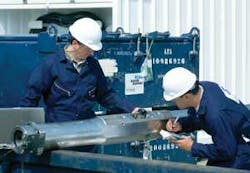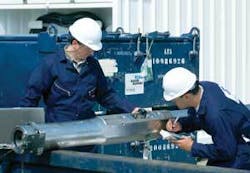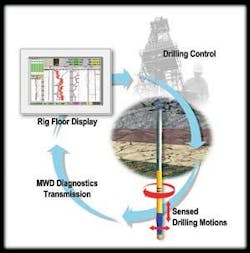Baker Hughes INTEQ lends new fidelity to MWD-LWD tools in quest for more accurate real-time drilling, formation evaluation data
Not only does MWD-LWD technology help operators to exploit targeted reservoirs more fully by measuring and capturing formation properties in real time as the well is drilled-before drilling fluids invade borehole walls too deeply-but the real-time well data delivered by such systems also assist the operator in maximizing drilling efficiency and wellbore placement.
In today’s deeper, more remote global drilling environment, where well paths are being steered directionally for longer distances with more precision to reach sweet spots, often in thinner reservoir sections, the ability to evaluate borehole conditions while drilling also can help lower well stability risks and significantly reduce non-productive rig time-the twin fetters to fruitful drilling economics.
Houston-based Baker Hughes INTEQ continues to develop new-generation MWD-LWD technologies to provide answers to operators’ demands for a more detailed understanding of the downhole drilling and, subsequently, completion environment.
According to Jeremy (Jez) Lofts, director of marketing-evaluation for LWD, coring and surface systems, INTEQ’s measurement scientists and logging research specialists are generating new while-drilling systems, yet remain actively engaged in ongoing programs to enrich the capabilities of the company’s existing MWD-LWD systems and tool suites. Consider the TesTrak formation pressure testing (FPT) while-drilling system, for instance.
Savings ‘impressive’ with while-drilling FPTs
Introduced in 2003 TesTrak, which conducts real-time FPT and delivers pressure and mobility data, was designed to enhance drilling efficiency and effect safer well dynamics, with data also applicable to mud program optimization.
“TesTrak delivers increased reservoir knowledge, yet creates the potential for some pretty impressive savings, since some operators choose to eliminate costly wireline or pipe-conveyed FPT logging runs,” said Lofts.
TesTrak, which Lofts characterized as “user-friendly,” has performed reliably around the world across a wide range of dynamic measurements, operating environments and hole sizes, including the North Sea and the Gulf of Mexico.
At the heart of the system, he said, is the SmartPad sealing technology, which establishes and maintains undisturbed pressure communication between the tool and the target formation throughout each FPT. With enhanced materials and design improvements, the sealing efficiency of the tool’s sealing pad has increased from an initial value of 81% to its current 95% average.
Also key to TesTrak effectiveness is the SmartTest intelligent testing control system, a closed-loop setup inside the tool that monitors and adjusts to formation conditions, eliminating the need for interaction from the surface, which can be time-consuming, Lofts pointed out. “The control draw-down pump permits individual FPTs to be made during drilling pauses of as brief as 45 seconds,” he added.
The TesTrak system can be employed for a range of test types, including standard, optimized repeated and successive draw-down tests, said Lofts.
“The pressure data can be used directly to set optimum casing points and to adjust the mud weight and equivalent circulating density (ECD), thus effectively and safely increasing ROP and to drill more safely into high-pressure zones,” he said, adding that the TesTrak system can deliver while-drilling pressure data from extended-reach horizontal wells without need for a separate wireline trip.
Formation pressure data has become a key while-drilling parameter in many producing regions, said Lofts. “As just one example, it was applied successfully recently in three deviated North Sea area wells with inclinations between 50 and 90 degrees,” he said, adding that 231 pressure points were tested at 89 points in those wells during 8 bit runs that totaled some 235 rotational hours.
“The total drilling distance covered by the tests was 10,780 feet (3,286 m),” he remarked, noting that post-well analyses of the pressure data added confidence to the real-time data acquired during drilling.
Co-Pilot for more drilling control
Another newly enhanced INTEQ MWD technology aimed at improving drilling optimization is the Co-Pilot® service, which records and processes downhole vibrational data, tendering real-time recommendations for lowering downhole risks associated with drilling.
According to Lofts, the Co-Pilot service delivers low-noise, high-speed simultaneous drilling dynamics and performance information to a rig floor display that gives the driller a new level of drilling process control.
“The tool measures stresses, pressures and vibrations simultaneously at a fast, 1,000-Hz data rate,” he said. “A downhole digital signal processor features software algorithms that determine any dysfunctions that might occur, such as stick-slip, bit bouncing, BHA whirl, etc., as well as their degree of severity. It transmits the information to the rig floor display in real time.” This capability, he added, helps the driller extend bit life and BHA for enhanced ROP, increases MWD reliability, and provides improved borehole quality.
Higher Fidelity
Building on INTEQ’s established acoustic while-drilling offering, the SoundTrak Advanced LWD Acoustic Service measures a wider range of accurate compressional slowness in real-time. “This SoundTrak capability is possible through an improved measurement design and dual-frequency operational modes,” said Lofts. “Now we can measure varying formation slowness in longer drilled intervals.” The SoundTrak Service quadrupole measurements operational envelope is extended also by using the dual-frequency capability, enabling a direct acquisition of shear slowness.”
“Such measurements can be used for a variety of real-time and post-well applications,” he said. “That includes seismic depth time to quickly determine formation depth and thickness.” The system also can calculate formation strength to identify sanding potential and other borehole stability issues in their early stages, he added.
Real-time updating of pre-drill models is possible when suitable data for pore pressure prediction are available, said Lofts. With SoundTrak, borehole acoustic velocities provide an accurate method for pore pressure prediction and are not sensitive to formation fluid salinity or variations in temperature, he noted.
“Real-time compressional slowness in conjunction with resistivity, unlike traditional quantitative resistivity methods, can further reduce uncertainty in updating pore pressure models while drilling,” he said.
Sharpening their Image
Definition of geological model while-drilling using borehole images is improved with INTEQ’s new-generation azimuthal density image along with azimuthal Pe. The new LithoTrak Advanced LWD Porosity Service allows for more comprehensive formation evaluation while providing better real-time decision making, explained Lofts. The introduction of an azimuthal caliper will allow for borehole stability evaluation while assisting in completion design decisions.
The RigLinksm Connection
INTEQ tackles the problem of bringing both real-time MWD-LWD data and information stored in tool memory to multiple surface points with its RigLinksm web-based communications system.
“With RigLink, users can view secure, current data from multiple rig sites around the world, using any type of computer, as long as it has an Internet connection,” he said. Using RigLink, both INTEQ and client personnel can access the company’s data to display all well real-time data.
RigLink is also used to feed while-drilling rigsite data into INTEQ’s BEACON centers where office-based experts provide real-time support to wells worldwide.
Taking advantage of recent commercial introduction of wired drill pipe “smart well” telemetry, INTEQ has developed interfacing technology for its tool suites so that their conventional mud-pulse and electromagnetic telemetry systems can be augmented by the new technology, said Lofts. This opens a whole new paradigm in real-time decision making and the associated technology application, said Lofts.
Looking ahead, Lofts said the MWD-LWD sector would continue seeking technology enhancements that result in higher resolution data acquisition and faster transmission. At the same time, he said, development will continue to bring measurements reliably closer to the bit. And, he added, INTEQ will continue to improve hostile environment performance capabilities of its MWD-LWD tools as operators extend drilling operations to more extreme environments.




